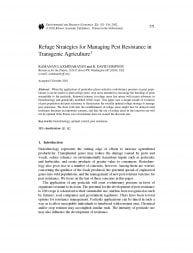May 27, 2010

When the application of pesticides places selective evolutionary pressure on pest populations it can be useful to plant refuge areas: crop areas intended to encourage the breeding of pests susceptible to the pesticide. Renewed interest in refuge areas has arisen with recent advances in biotechnology and genetically modified (GM) crops. This paper uses a simple model of the evolution of pest population and pest resistance to characterize the socially optimal refuge strategy to manage pest resistance. We show both that the establishment of refuge areas might best be delayed until resistance becomes an important concern, and that the use of refuge areas in the long-run use will not be optimal if the fitness cost of resistance does not exceed the discount rate.

